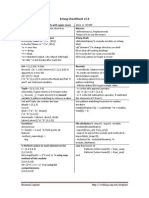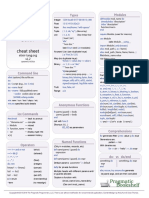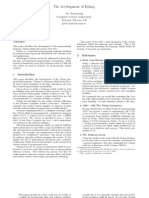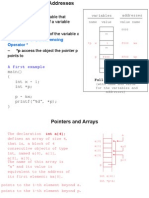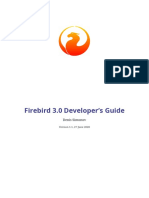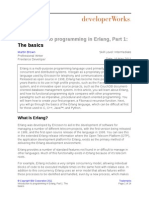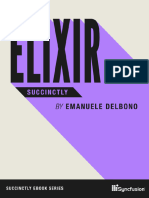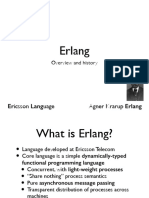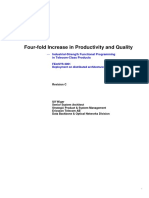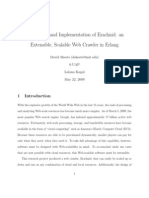Introduction to Erlang
Erlang is a functional, concurrency-oriented,
distributive, fault-tolerant programming
language.
1
�Philosophy of Erlang
Erlang was designed for writing concurrent programs
that "run forever". - Joe Armstrong
Let it fail. Have another process deal with it.
Fault tolerance requires at least *two* computers.
2
�Erlang Mindset
Lots of little tasks
Tons of processes
Each process does a task very well
Ant Colony
Ants are processes sending messages to each other
3
�Why Erlang?
4
�Erlang makes hard things
easier.
5
�Concurrency
6
�7
�Spawning Processes
8
�F = fun() ->
io:format(hi)
end,
spawn(F).
>> hi<0.34.0>
9
�spawn(io, format, [hi]).
10
�Message Passing
11
�12
�Pid ! Message
Pid ! {do_task, run_home}
Pid ! 2
13
�receive ... end
receive
Pattern1 [when Guard1] ->
Expressions1;
Pattern2 [when Guard2] ->
Expressions2
end.
14
� Messages are contained in a processs
inbox.
receive
_ ->
ok
end.
15
�Fault Tolerance
16
�17
�18
�which is why erlang was
designed to be....
19
�Distributive
20
�21
�Pid ! Message
where Pid exists on another node.
22
�Erlang Nodes
Can only talk if the erlang cookie is the same
Can exist on the same machine or different machines
Does have overhead, isnt free
Can have C nodes (+ other node types that speak
erlang)
Communicate via Global Name Registry, Specific Pids,
or by Node name
23
�The Basics
24
�Erlang is Functional
25
�Periods, Commas,
Semicolons Oh My!
People think Erlangs syntax is ugly. Its actually
very logical.
26
�Periods ( . ) end everything except when
Semicolons ( ; ) end clauses
and Commas ( , ) separate expressions.
27
�calculate_area({square, Size}) ->
Size * Size;
calculate_area({circle, Radius}) ->
Pi = 3.14,
Pi * Radius * Radius;
calculate_area(_Unknown) ->
ok.
28
�case Expression of
{do_task, run_home} ->
Home = 123,
spawn(run, home, [Home]);
_ ->
ok
end.
29
�Data Types
30
�Integer - however big you can imagine
Floats
Atoms - similar to a ruby symbol, they are used to
represent non-numerical constants (true, false, ok,
error)
Tuple - Fixed length collection of items ({one, two,
three} or {one, two} etc)
Lists - Stores a variable number of things ([1, 2, {one,
two}, $a])
31
�Missing Links...
32
�Strings - A string is just a list of integers in erlang.
Booleans - Use atoms (true, false)
Hash - Property List ( [tuple()] ) shown later
33
� Pattern Matching
Once you pattern match, variable assigning feels dirty.
34
�1 = 1 ( ok )
1 = 2 ( error thrown bad_match )
Value = {2, 4},
{Width, Height} = {2, 4} ( ok )
[Head|Tail] = [1,2,3,4] ( ok )
35
� Variable Binding
or restricting infinite possibilities.
36
� An unbound variable can be anything it
needs to be (infinite possibilities)
A.
37
� Pattern matching an unbound variable is
like restricting what it can be.
A = 1.
A = 2. (error bad_match)
38
� Tuples
Single entity that holds a collection of items.
39
�{1, 2, 3}.
{one, two}.
{user_id, 2, user_name, asceth}.
40
� Lists
Variable sized container of items.
41
�List = [1, 2, 3],
NewList = List ++ [4, 5, 6].
>> [1, 2, 3, 4, 5, 6]
[Head|Tail] = NewList.
>> Head -> 1
>> Tail -> [2, 3, 4, 5, 6]
42
� [tuple()]
Property Lists or semi-hashes.
43
�PList = [{key, value}, {key1, value1}].
case lists:keysearch(key, 1, PList) of
false ->
error;
{value, {Key, Value}} ->
Value
end.
44
�keydelete - deletes tuple with specified key in list of
tuples and returns new list
keymap - returns list of tuples where Nth element is
replaced be specified fun
keymember - tests for existence of key
keymerge - combines two tuples with tuple1 taking
priority
ukeymerge, ukeysort - like keymerge but removes
duplicates in tuple2
45
� Functions
Pattern matching, Function Arities & more
46
�Functions with the same name can exist
Functions with the same name and different arity can
exist
Erlang tells you if a function cannot be called due to
order of definement
Function order is very important
47
�contains(Key, []) ->
false;
contains(Key, List) ->
lists:any(fun(X) -> Key == X end, List).
contains(1, [1, 2, 3]).
true
contains({home, 123}, [{apartment, 333}, {house, 000}]).
false
48
�Anonymous
49
�contains(Key, []) ->
false;
contains(Key, List) ->
lists:any(fun(X) -> Key == X end, List).
F = fun(X, Y) ->
X1 = X * 2,
Y1 = Y * X,
X1 + Y1
end,
F(2, 2).
>> 12
50
� Looping
Tail recursion makes looping good again.
51
�print([]) ->
ok;
print([H|T]) ->
io:format(~p~n, [H]),
print(T).
52
� Conditionals
Ifs are okay, cases are cooler.
53
�if
A == 5 ->
do_something();
true ->
do_something_else()
end.
54
�case A of
0 ->
first();
2 ->
second();
_ ->
something()
end.
55
�Resources
http://www.erlang.org
Technorati
56
�57
�Questions?
58


